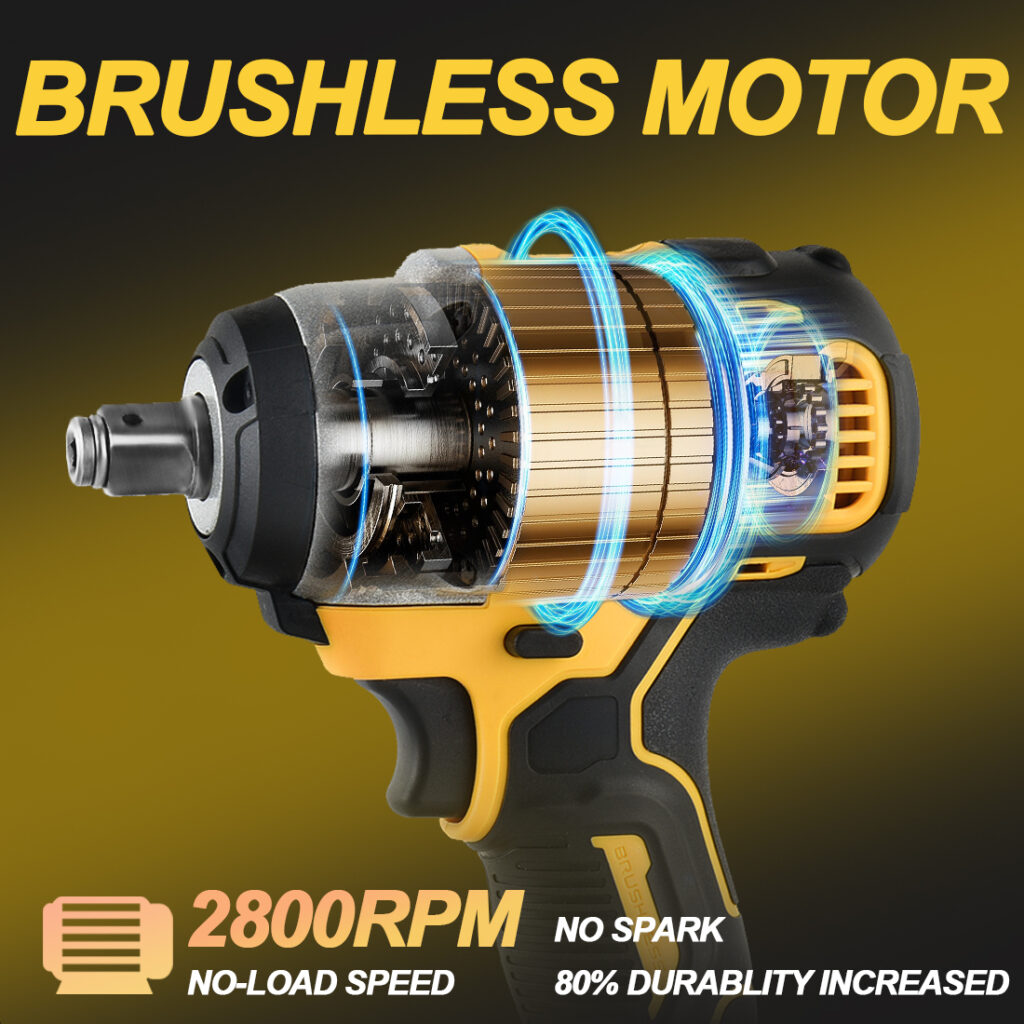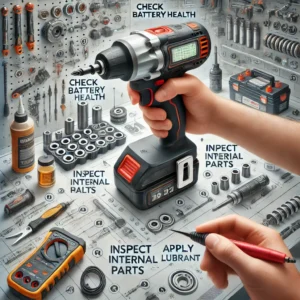In today’s fast-paced industrial environments, tool design plays a pivotal role in enhancing worker productivity while ensuring safety. Among these tools, cordless impact wrenches have gained widespread use in various industries, including automotive repair, construction, and manufacturing. However, one often overlooked yet crucial aspect of their development is ergonomic design. Studies have consistently shown that ergonomically designed tools can dramatically reduce fatigue, improve accuracy, and enhance overall efficiency. In the case of cordless impact wrenches, ergonomics is not just a matter of comfort—it’s directly tied to worker safety and long-term productivity.
This article explores the ergonomic aspects of cordless impact wrenches, focusing on features that enhance usability, minimize fatigue, and improve the overall safety of the user.
1. Understanding Ergonomics in Tool Design
Ergonomics refers to the science of designing products, environments, and systems that fit the users’ capabilities and limitations. In the context of cordless impact wrenches, ergonomic design is about optimizing the tool’s shape, size, weight, balance, and controls to reduce strain and prevent injury during operation. A well-designed cordless impact wrench should enable users to work longer without experiencing discomfort or fatigue, while also promoting safety and efficiency.
The key ergonomic principles that influence cordless impact wrench design include:
- Reduction of strain on muscles and joints: The tool’s design should minimize the amount of force needed to operate it, reducing the risk of repetitive strain injuries.
- Comfortable handling: A proper grip, well-placed controls, and a balanced weight distribution can all make the tool more comfortable to use over extended periods.
- Vibration and noise reduction: Lowering vibration levels and reducing noise can prevent long-term health issues such as hand-arm vibration syndrome (HAVS) or hearing damage.
2. Handle and Grip Design: The Foundation of Comfort
The handle is one of the most important aspects of a cordless impact wrench’s ergonomic design. The way a user holds the tool can directly affect their comfort, control, and safety. Modern impact wrenches often feature handles that are contoured or textured to fit the hand’s natural shape. The addition of rubber or soft-grip materials further enhances comfort, providing a secure and slip-resistant grip, even when the user’s hands are oily or sweaty.
An ergonomic handle should:
- Fit a variety of hand sizes: The handle should accommodate users with different hand sizes and offer a secure grip for all.
- Promote a natural wrist position: By angling the handle slightly or shaping it to reduce the need for awkward wrist movements, the design can prevent unnecessary strain on the wrist and forearm.
- Minimize gripping force: A well-designed grip reduces the amount of force needed to hold and control the tool, which lowers hand fatigue.
An ideal grip ensures that users maintain control without needing to overexert themselves, making tasks easier and more efficient.A study by the European Agency for Safety and Health at Work (EU-OSHA) found that the use of ergonomically designed handles reduces the incidence of wrist and hand strain by up to 42% .

3. Weight and Balance: Improving Control and Reducing Fatigue
Another key factor in the ergonomics of cordless impact wrenches is the tool’s weight and balance. A heavy tool can cause arm and shoulder fatigue, particularly when used for extended periods or in awkward positions, such as working overhead. Conversely, a lightweight, well-balanced tool can significantly enhance comfort and reduce the risk of muscle strain. A study published by the National Institute for Occupational Safety and Health (NIOSH) found that tools weighing more than 2.5 kg increase the likelihood of musculoskeletal strain by 35% compared to those under 2 kg .
The weight of cordless impact wrenches often depends on the size of the battery and the materials used in their construction. Advances in lithium-ion battery technology have allowed manufacturers to develop more powerful and lighter batteries, reducing the overall weight of the tool. Additionally, using lightweight materials like magnesium or reinforced plastic in the tool’s body can help to further lower its weight without sacrificing durability.
Balance is equally important in ergonomic design. The placement of the motor and battery affects the tool’s center of gravity. Ideally, the weight should be distributed in such a way that the tool feels balanced in the user’s hand, with no need to constantly adjust grip or strain the wrist to maintain control. A well-balanced tool reduces fatigue and allows for more precise movements, which is critical when working on delicate or high-torque applications.

4. Vibration Control: Protecting the User’s Health
Impact wrenches, by their nature, produce significant vibrations. If not properly controlled, these vibrations can lead to health issues like hand-arm vibration syndrome (HAVS), which affects the nerves, blood vessels, and joints in the hands and arms. To address this, ergonomic cordless impact wrenches are designed with vibration-dampening features.
Some of the methods used to reduce vibration include:
- Rubberized grips: These can absorb some of the vibrations before they reach the user’s hands.
- Internal dampening systems: Some impact wrenches are built with shock-absorbing systems that reduce the transmission of vibration from the motor and impact mechanism to the user.
- Low-vibration motors: Advances in motor design can help reduce the overall vibration produced by the tool.
By reducing vibrations, cordless impact wrenches not only protect the user from potential long-term health risks but also make the tool easier and more comfortable to use for extended periods.
5. Trigger and Control Positioning
Ergonomics is not just about how a tool feels but also how easy it is to use. The placement of controls, especially the trigger, should be intuitive to minimize unnecessary hand movement. This is particularly important for cordless impact wrenches, as users often need to toggle between forward and reverse motions. Poorly placed controls can force awkward hand positions, which increase the risk of repetitive strain injuries (RSIs).
The ideal ergonomic design includes a well-positioned, sensitive trigger that requires minimal force to activate. Additionally, having a forward/reverse control switch within thumb or finger reach can further reduce the strain of constant movement, leading to more efficient tool operation.

6. Compact and Portable Design: Optimizing for Tight Spaces
Cordless impact wrenches are often used in environments where space is limited, such as automotive repair shops or industrial machinery maintenance. A compact design allows users to maneuver the tool into tight spaces without compromising control or comfort. Compact cordless impact wrenches often have shorter lengths or slimmer profiles, making them ideal for use in confined areas where larger tools would be impractical.
Portability is another advantage of ergonomic cordless impact wrenches. Since they are not tethered to a power source, users can move freely around the workspace, increasing productivity and reducing the need to stop and reposition the tool. This freedom of movement allows users to position themselves in more comfortable and ergonomic postures, reducing the risk of injury or strain.
7. Noise Reduction: Enhancing the Working Environment
Noise pollution is a common issue with power tools, including impact wrenches. Exposure to high noise levels for extended periods can lead to hearing damage and increase stress. While hearing protection is often recommended, some ergonomic designs aim to reduce the noise generated by the tool itself.
Noise-reducing features, such as insulated housings or quieter motor designs, can make the working environment more pleasant and safe for users. A quieter tool also allows for better communication on job sites, which can enhance safety and coordination among workers.

8. Cordless Flexibility: Freedom of Movement Without Compromise
One of the biggest advantages of a cordless impact wrench is the flexibility it offers. Without the need for a power cord, users can work in various positions and locations, free from the restrictions of traditional corded tools. This flexibility is a significant ergonomic benefit, as it allows users to work in more natural postures and reduce awkward body positions that can lead to strain or injury.
The cordless nature of these tools also allows for greater efficiency, as users don’t need to worry about cord management or finding power outlets. This freedom of movement is especially valuable in outdoor or remote worksites, where power sources may be limited.
9. Conclusion: Ergonomics as a Driver of Productivity and Safety
Ergonomics is a fundamental aspect of cordless impact wrench design that directly influences the comfort, safety, and productivity of users. By focusing on features like comfortable grips, balanced weight distribution, vibration dampening, intuitive control placement, and compact designs, manufacturers can create tools that meet the demands of professionals while reducing the risk of fatigue and injury.
As cordless impact wrenches continue to evolve, ergonomic considerations will remain at the forefront of design innovation, ensuring that these tools not only perform well but also protect the well-being of the users who rely on them daily. For professionals and DIYers alike, choosing an ergonomically designed impact wrench can make all the difference in achieving greater efficiency and comfort on the job.



